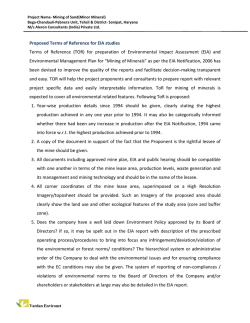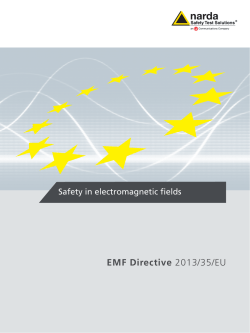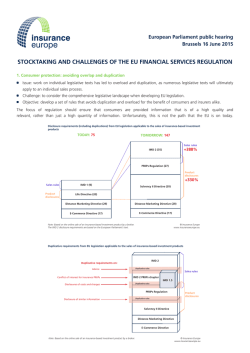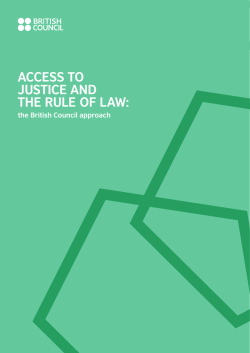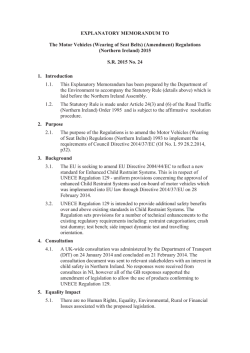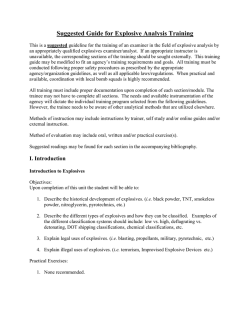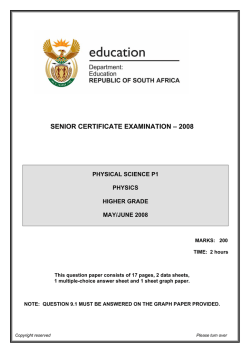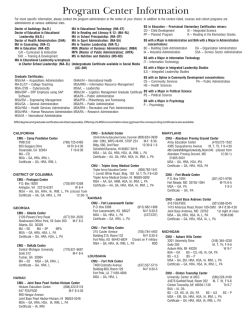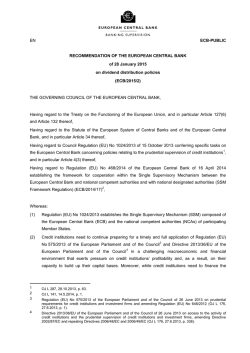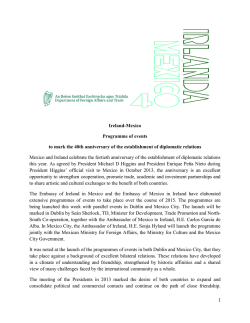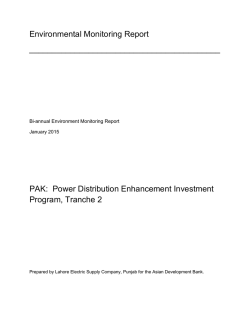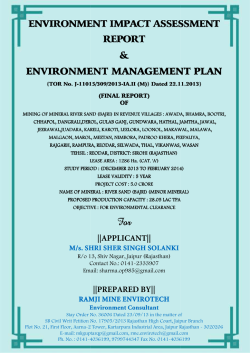
10 concerns about Dalradian gold mine
northern ireland A case study of institutional failure to protect a special river Friends of Earth Northern Ireland (FOE NI) is concerned about systemic and persistent errors made by the Department of the Environment (DOE) in the processing of Dalradian’s planning application, and attendant issues around enforcement and the management of the public interest in this case. Having monitored major planning applications for a number of years that give rise to significant environmental impact, FOE NI contends that this case highlights a catalogue of errors in carrying out the DOE’s statutory duties in relation to the environment. FOE NI has also taken the unprecedented step of serving notice on the Department under the Environmental Liability Directive because of major concerns caused by the importation of infill materials on the site and the risk of pollution to the river during salmon spawning season. It is difficult to ignore the conclusion that the Department has undermined the legitimate planning, environmental and community public interest in this case. If the behaviour by the DOE simply represented a dereliction of duty in relation to the fulfilment of legal obligations FOE NI would not issue this briefing. One real concern is the exposure of the taxpayer to major fines from Europe. Much more important however is the abdication of government’s responsibility to protect one of the most significant sites for biodiversity left in Northern Ireland and the precedent set in applying these declining standards to what remains. The ten concerns 1. Given the very close proximity of this mine to a very sensitive habitat, afforded the highest level of environmental protection under European law, it is inconceivable that an Environmental Impact Assessment (EIA) was not required. The absence of an EIA is despite the fact that the Department could not rule out likely significant environmental effects which were subsequently identified by the Department for the Owenkillew River Special Area Conservation (SAC) through the Habitats Regulation Assessment process required by the Habitats Directive. There was an inadequate EIA screening because the DoE failed to identify significant environmental effects and therefore breached EU law under Article 2(1) of the EIA Directive and the ruling of the European Court of Justice, case C12/02 (Waddenzee) and national case law in Northern Ireland. The law is clear – environmental impacts must be correctly assessed and fully understood before planning permission can be granted. The Department considered that for the purpose of the EIA Regulations the effects would not be significant and therefore no EIA was required. However, the same Department subsequently identified significant effects for the purpose of HRA. European guidance seems clear that where a HRA is deemed necessary, so is EIA (European Commission Guidance: Assessment of plans and projects significantly affecting Natura 2000 sites, page 12, para. 2.4). This river is the last major stronghold for freshwater pearl mussels in Northern Ireland, an endangered European species, and a river also designated for its populations of Atlantic Salmon and otter. The site of the mine is only a few hundred yards above one of the most important parts of the river for wildlife. 2. The precautionary principle, a fundamental principle of European environmental Directives that pertain to this site, has been breached because the DoE required detailed information showing new development to be submitted after the decision was made and approval granted thereby circumventing the need to environmentally assess the full impact of the project. These elements include: the design of key elements such as final plans of the water treatment plant explosives store relocation the importation of materials onto the site The requirements of Art 6(3) of the Habitats Directive are strictly precautionary and there can be no lacunae, as confirmed in the recent ruling of Sweetman-v-An Bord Pleanala. The absence of information introduces scientific uncertainty, which Art 6(3) does not permit, as clearly established by the Court of Justice of the European Union, in this recent ruling. 3. The Aarhus Convention is being violated – the public has been denied the right to participate in the decision making process because important issues are being agreed after the decision was made. There has also been an absence of meaningful consultation with the local community, and no effective redress when legitimate issues and concerns are being raised. 4. The frequency and the seriousness of basic mistakes are disturbing. For example, the Habitats Regulations Assessment (HRA) as required by the EU Habitats Directive appears to have been prepared for another river (the River Roe). Furthermore, the cumulative impacts of this development were not adequately considered, nor were risks and threats that were known to the DoE in other documents identified in the HRA. Even when the HRA identified significant effects these were not identified in the EIA screening. 5. The explosives store has been approved on active bog (as confirmed in a report by a leading ecologist), a habitat specifically protected under Annex 1 of the Habitats Directive and yet this never formed part of the original planning application, contrary to Article 6(3) of the Habitats Directive and domestic legislation. There does not appear to be control over access to the site of the explosives store. The fact that the explosives store required a new application is an indication that it did not form part of the original application, nor was it considered for its environmental effects under EIA or HRA. The public and consultees may have also been misinformed because there was no assessment of the explosives store on peat bog in the planning application. There were no detailed drawings of an explosives stores in the original application or consideration in consultation responses, the EIA determination, case officer’s report, and development management group report or the decision notice of the original application K/2013/0072/F. Both a leading UK planning consultant for objectors (Michael Burroughs Associates) and the legal advisors for Dalradian have confirmed in writing that it is not lawful to approve a full planning application without full details. Burroughs Associates provided details of established case law in support of its position, yet the Department continues to conceal its errors by insisting it had sufficient detail for this and many other points. 6. The proposed removal of the two planning conditions in a new application (K/2014/0246/F) because of a “conflict” with the subsequent consent to discharge, is a clear indication that the DOE took a decision contrary to Regulation 43 of the Habitats Regulations. These conditions were originally imposed to safeguard the protected fresh water pearl mussel and other aquatic life. Moreover, the conditions imposed regarding water quality monitoring confer selfmonitoring to the developer that is inconsistent with the Department’s duties as a competent authority to protect a European site. 7. The DOE has prevented the renovation of a vernacular house that arguably fully complies with planning policy (and may not even have needed planning permission) because of a development, namely an explosives store, that was not at the time subject to the public planning process, as no details were contained in the original planning approval. This is a very significant precedent for rural housebuilding. It even appears that the local planning office was of the opinion the works to the vernacular building that were carried out did not require planning permission and that no enforcement action could be taken, yet this was overruled by planning HQ presumably to facilitate approval of the Dalradian explosives store. 8. Minister Durkan gave objectors assurances that stringent conditions would be imposed. It is now clear that conditions could be removed that were designed to protect the integrity of the important SAC river. These conditions were insisted on by NIEA yet the relevant part of NIEA had ‘no comment’ to make when consulted about their removal. FOE NI is also confused as to why consent to discharge was assessed after planning approval and subsequently incorporated into the HRA, yet the Department claimed it was assessed at time of the initial HRA and granted prior to planning approval issuing. Detailed cross-sections and proposed levels are normally required of any proposal to develop a sloping site, yet none were contained in the original application. Nor was the importation of infill material on the site, from unknown provenance, properly assessed, breaching the Department’s own standards. 9. The last and only other gold mine approved in Northern Ireland was the subject of a detailed public inquiry and a thorough Environmental Impact Assessment, and approved at Cavanacaw, also in County Tyrone. Twenty years on since these assessments for Cavanacaw, neither a public inquiry nor an EIA were carried out for this gold mine at Gortin despite the site being much more sensitive to environmental risk. (Given the scale of this project it is not tenable to argue that the Gortin gold mine is only exploratory). The Ombudsman has recently reported on the Cavanacaw case and discovered major planning irregularities and found in favour of local residents claiming there was a systemic failure in enforcement and other issues. It seems that lessons have not been learned. 10. Despite many concerns about the planning of minerals and quarries, the recent publicity around the lack of planning permission or environmental regulation of sand extraction from Lough Neagh Special Protection Area, and the very high levels of retrospective mineral approvals, FOE considers that this seminal case at Gortin is symptomatic of declining standards in how mineral applications are assessed, and demonstrates a failure to comply with basic principles of planning and environmental law. Friends of the Earth also holds concerns in relation to how legitimate points of public interest and indisputable facts have now been censored by the DoE through the redaction of our representations in the public access planning portal of the DoE website. (http://www.foe.co.uk/northern-ireland/news/friends-earth-censored). Without the public examination of our legal responsibilities to the environment and with the closing down of opportunities for public participation it now seems inevitable that basic errors will be repeated at a very high cost to public confidence in the health of the planning and regulatory system for mineral applications.
© Copyright 2025
